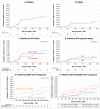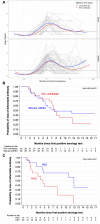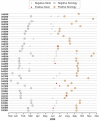HIV and SARS-CoV-2 infection in postpartum Kenyan women and their infants
- PMID: 36649247
- PMCID: PMC9844875
- DOI: 10.1371/journal.pone.0278675
HIV and SARS-CoV-2 infection in postpartum Kenyan women and their infants
Abstract
Background: HIV may increase SARS-CoV-2 infection risk and COVID-19 severity generally, but data are limited about its impact on postpartum women and their infants. As such, we characterized SARS-CoV-2 infection among mother-infant pairs in Nairobi, Kenya.
Methods: We conducted a nested study of 62 HIV-uninfected and 64 healthy women living with HIV, as well as their HIV-exposed uninfected (N = 61) and HIV-unexposed (N = 64) infants, participating in a prospective cohort. SARS-CoV-2 serology was performed on plasma collected between May 1, 2020-February 1, 2022 to determine the incidence, risk factors, and symptoms of infection. SARS-CoV-2 RNA PCR and sequencing was also performed on available stool samples from seropositive participants.
Results: SARS-CoV-2 seropositivity was found in 66% of the 126 mothers and in 44% of the 125 infants. There was no significant association between SARS-CoV-2 infection and maternal HIV (Hazard Ratio [HR] = 0.810, 95% CI: 0.517-1.27) or infant HIV exposure (HR = 1.47, 95% CI: 0.859-2.53). Maternal SARS-CoV-2 was associated with a two-fold increased risk of infant infection (HR = 2.31, 95% CI: 1.08-4.94). Few participants (13% mothers, 33% infants) had symptoms; no participant experienced severe COVID-19 or death. Seroreversion occurred in about half of mothers and infants. SARS-CoV-2 sequences obtained from stool were related to contemporaneously circulating variants.
Conclusions: These data indicate that postpartum Kenyan women and their infants were at high risk for SARS-CoV-2 infection and that antibody responses waned over an average of 8-10 months. However, most cases were asymptomatic and healthy women living with HIV did not have a substantially increased risk of infection or severe COVID-19.
Copyright: © 2023 Begnel et al. This is an open access article distributed under the terms of the Creative Commons Attribution License, which permits unrestricted use, distribution, and reproduction in any medium, provided the original author and source are credited.
Conflict of interest statement
The authors have declared that no competing interests exist.
Figures



References
-
- Kenya Ministry of Health. Kenya Health and Research Observatory COVID-19 Tracker. 2021 [cited 7 Jul 2022]. Available: https://khro.health.go.ke/#/covid_19_tracker
-
- Kenya Ministry of Health. First Case of Coronavirus Disease Confirmed in Kenya. 2021 [cited 26 May 2021]. Available: https://www.health.go.ke/first-case-of-coronavirus-disease-confirmed-in-...
-
- Our World in Data. Kenya: Coronavirus Pandemic Country Profile. 2021 [cited 5 Jul 2022]. Available: https://ourworldindata.org/coronavirus/country/kenya
-
- Nextstrain. Genomic Epidemiology of Novel Coronavirus—Africa-focused Subsampling. 2021 [cited 25 Jun 2021]. Available: https://nextstrain.org/ncov/africa?f_country=Kenya
-
- UNAIDS. Country Factsheets: Kenya 2019. 2019 [cited 23 Jun 2021]. Available: https://www.unaids.org/en/regionscountries/countries/kenya
Publication types
MeSH terms
Substances
Grants and funding
LinkOut - more resources
Full Text Sources
Medical
Research Materials
Miscellaneous

